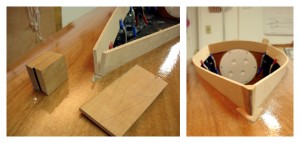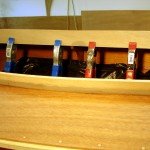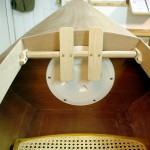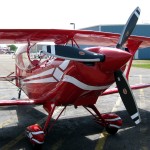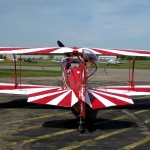Making paddles is easy. Some say even children can learn to make them. So, I enjoy the childlike satisfaction of paddle making. The great thing about them is they can be done in a matter of a few hours, not days, or weeks … unless you really want to drag out the making, and the enjoyment.
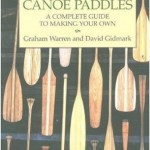 My general guide is “Canoe Paddles” by Warren and Gidmark. Enough variations exist in that book to keep a paddle maker occupied for a long time. While the book focuses mostly on single paddles, there are a few pages about double paddles, and plenty of information about a variety of construction techniques.
My general guide is “Canoe Paddles” by Warren and Gidmark. Enough variations exist in that book to keep a paddle maker occupied for a long time. While the book focuses mostly on single paddles, there are a few pages about double paddles, and plenty of information about a variety of construction techniques.
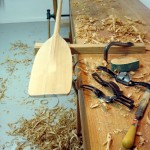 This is my third double paddle. I take the simple approach, using western red cedar, no fancy laminations, no exotic woods. Today, I’m learning. I anticipate fancier paddles later. This paddle is 7 feet 6 inches long and has straight blades. The construction is a lamination of the loom and four blades. The loom is oval in cross section, and measures 1 and 1/8 inch by 1 and 1/2 inch. The oval cross section fits easily in the hands making blade orientation automatic. The thick part of the blades is 1/2 inch thick, tapering to 3/16 inch at the edges. Keeping things simple, I do not add reinforced tips. Those will come another day.
This is my third double paddle. I take the simple approach, using western red cedar, no fancy laminations, no exotic woods. Today, I’m learning. I anticipate fancier paddles later. This paddle is 7 feet 6 inches long and has straight blades. The construction is a lamination of the loom and four blades. The loom is oval in cross section, and measures 1 and 1/8 inch by 1 and 1/2 inch. The oval cross section fits easily in the hands making blade orientation automatic. The thick part of the blades is 1/2 inch thick, tapering to 3/16 inch at the edges. Keeping things simple, I do not add reinforced tips. Those will come another day.
My long bench and its leg vise make work holding easy. The tools are simple. An old Stanley spokeshave does most of the shaping. The two tools in the foreground are Snell and Atherton leather shaves. They were originally cobblers’ tools for boot making, but work extremely well with soft woods. I use them for the concave areas in the throats where the blades blend with the loom. That little French curved sanding block is really handy for final smoothing.
Paddle making is much like sculpting. It’s all curves, gently shaping and refining, feeling the wood constantly. I find it very enjoyable.
Finish is tung oil, the real stuff, not the blend of oil and varnish often found at the Borg.
This completed paddle will show up in the launch day picture(s).
